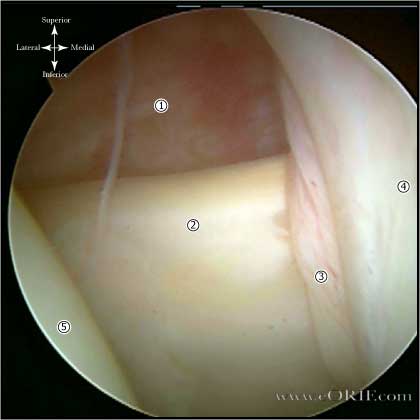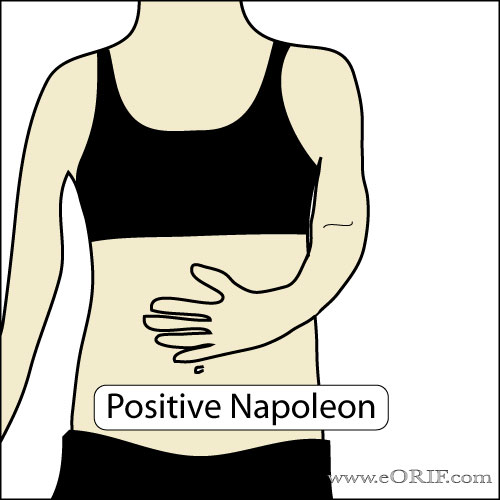|


|
synonyms:
Subscapularis ICD-10
A- initial encounter
D- subsequent encounter
S- sequela
Subscapularis ICD-9
- 840.5 (Sprains and strains - Subscapularis)
Subscapularis Etiology / Epidemiology / Natural History
- uncommon, most rotator cuff tears involve the supraspinatus, but isolated subscapularis tears and supraspinatus tears with associated subscapularis tears do occur and are purhaps more common than previously believed.
- Subscapularis tears are generaly partial thickness. Reported to be seen in 19% of shoulder scopes. 90% have an associated supraspinatus tear (Kim TK, AJSM 2003;31;744).
- Acute tears may occur in association with anterior glenohumeral dislocation. (Neviaser RJ, JSES 1995;4:416)
- Classic Mechanism: forced ER or hyperextension for acute tears.
- Generally in 50's; Male > female; generally partial tears; generally present in a delayed fashion. (Kruez PC, AJSM 2005 33: 1831) (Edwards TB, JBJS 2005;87:725)
- 68% traumatic, 32% degenerative; 64% associated biceps instability, 12% biceps rupture (Edwards TB, JBJS 2005;87:725?
- Have been reported to occur with aggressive muscular contraction (throwing). (Yashikama, G, JSES 2005;14:218)
Subscapularis Anatomy
- Origin = ventral scapula, Insertion = lesser tuberosity of humerus and humeral metaphysis. Innervation = upper and lower subscapular nerves.
- Principle function = internal rotation of the humerus. Also important for anterior stabilization of the glenohumeral joint.
- Anterior subscapularis is balanced against the posterior infraspinatus and teres minor = transverse plane force couple (Lo IK, AJSM 2003;31:308).
- Comma sign = Remnants of the superior glenohumeral and medial coracohumeral ligaments are seen retracted from the lesser tuberosity in patients with subscap tears when viewed arthroscopically which can be used to locate the torn subscapularis tendon (Lo IK, Arthroscopy 2003;19:334).
Subscapularis Clinical Evaluation
- Generally anterior shoulder pain, may or may not have associated traumatic event. Often complain of night pain and IR weakness.
- Anterior shoulder tenderness on exam.
- Increased passive external rotation is found in complete tears.
- Weakness in Internal Rotation.
- Lift-Off test: patient places hand behind their back and at the lumbar level and lifts it away from the back. An inability to hold hand away from the back is indicative of supscapularis tearing. (Gerber C, JBJS 1991;73B:389).
- Abdominal Compression test: patient presses palm against their abdomin with the wrist in neutral position and the elbow anterior to the thorax. Wrist volar flexion and the elbow falling posterior to the thorax when patient presses indicates a complete supscapularis tear. (Burkhart SS, Arthroscopy 2002;18:454).
- Lift-Off Lag Test:
- Napoleon Test:
- Bear-Hug Test:
- Belly-Off Sign:
- Sensitivities: bear-hug test = 60%, belly-press test = 40%, Napoleon test = 25%, Lift-off test = 18%. (Barth JRH, Arthroscopy 2006;22:1076)
Subscapularis Xray / Diagnositc Tests
- A/P, Grashe, axillary and suprapsinatus outlet views are indicated. Plain films are often normal. Chronic tears may demonstrate anterior subluxation of the humeral head on axillary view. (Travis RD, Orthop Cin North Am 2001;32:495)
- supine axillary view is perhaps best to identify glenohumeral joint narrowing and the presence of an unfused acromial epiphysis. In a patient who has undergone previous surgery, this view also can reveal that amount of acromion which remains.
- Arthrography: easily interpretable, and can clearly identify the presence or absence of a full-thickness tear. Disadvantages invasive, limited to identification of full-thickness tears only, rarely gives information about quality of the tendon or the precise location of the tendons that are torn. CT arthrography with contrast extravasation onto the lesser tuberosity indicates subscapularis tear (Walch G, JSES 1994;3:353).
- MRI = Subscapularis tears are best visualized on T2-weighted axial images. (Pfirrmann CW, Radilogy 1999;213:709) May give information about associated biceps instability and associated muscle atrophy or fatty infiltration. Medial subluxation of the long head of the biceps is highly associated with complete rupture of the subscap. Narrowed coracohumeral distance (<6mm) is associated with subscapularis tears. (Richards DP, Arthroscopy 2005;21:1223) Disadvantages are patient claustrophobia, cost.
- Ultrasonography: Nearly as accurate and less expensive as compared to MRI. Difficulty identifying small tears, partial tears, and even degenerative and scarred tissue may look similar. Operator dependent. (Teefey SA, JBJS 2000;82A:498).
Subscapularis Classification / Treatment
- Atraumatic tears: generally treated non-operatively with activity modifications, NSAIDS, physical therapy.
- Acute Complete Tear: prompt repair is indicated for best outcome. Generally repaired open. Biceps tenodesis or tenotomy during repair is associated with improved outcomes (Edwards TB, JBJS-AM 2005;87:725-730 )
- Chronic Complete Tear: repair is often impossible and can require tendon/muscle transfers. (Galatz LM, JSES 2003;12:1). Pec Major transfer provides good outcomes provided the supraspinatus is intact or repairable (Jost B, JBJS 2003;85A:1944).
- Full Thickness,Partial Length: typically involve intra-articular portion of tendon and may be associated with supraspinatus tear. Generally repaired arthroscopically with concomittant biceps tenodesis. (Burkhart SS Arthroscopy 2002;30:810), (Kim SH, AJSM 2005;33:1825), (Lafosse L, JBJS 2007;89:1184).
- CPT CODING for arthroscopic repair of the supraspinatus and subscapularis tendons through separate incisions/portals: CPT Code 29827-22 (arthroscopic rotator cuff repair is reported once regardless of number of tendons repaired. Adding modifier 22 for the additional complexity of added portals and time for subscapularis and documment medical necessity)
- After TSA: chronic subscapularis insufficiency that affects AROM/activity best treated with conversion to reverse TSA.
- Acute tear after TSA in early post-op period: operative repair.
- (Warner JJ, JSES 2001;10:37)
- Arthroscopic bicipital sheath repair (Bennett WF, Arthroscopy 2004;20:964).
Subscapularis Associated Injuries / Differential Diagnosis
- RTC tear (supraspinatus)
- Long head of biceps tendon subluxation/dislocation/rupture: 31%-56% of isolated subscap tears (Deautsch A, AJSM 1997;25:13), (Gerber C, JBJS 1996;78A:1015)(Walch G, JSES 1998;7:100).
- frozen shoulder, instability, glenohumeral arthritis, AC disorders, fibromyalgia
- calcific tendonitis, cervical radiculitis, viral plexopathy(Parsonage-Turner syndrome)
- also see Massive RTC Tear
- Internal Impingement
Subscapularis Complications
- Re-rupture, infection, RSD, stiffness, NVI(musculocutaneous/axillary), arthritis
Subscapularis Follow-up Care
- Subjective results of repair=54% Excellent, 36% Good, 8% Fair, 2% Poor. (Edwards TB, JBJS-AM 2005;87:725-730 )
- Post-op: sling, elbow/wrist/hand ROM exercises. No lifting.
- 7-10 days: Continue sling. Begin gentle passive and active-assisted ROM exercises. No external rotation past 0º.
- 6 weeks: begin progressive active-assisted and active ROM exercises.
- 3 months: begin strengthening.
Subscapularis Review References
- Deutsch A, AJSM 2007;25:13
- Lyons RP, JAAOS 2005;13:353
- Warner JJ, JSES 2001;10:37
- Edwards TB, JBJS 2006;88A:1
- Levy JC, Kalandiak S. Radiographic appearance of displaced lesser tuberosity osteotomy: a case series. J Shoulder Elbow Surg. 2011 Apr;20(3):395-400. doi: 10.1016/j.jse.2010.07.015. Epub 2010 Nov 4.
- Shi LL, Jiang JJ, Ek ET, Higgins LD. Failure of the lesser tuberosity osteotomy after total shoulder arthroplasty. J Shoulder Elbow Surg. 2015 Feb;24(2):203-9. doi: 10.1016/j.jse.2014.05.006. Epub 2014 Aug 5.
- Schmidt CC, Jarrett CD, Brown BT, DeGravelle M Jr, Sawardeker P, Weir DM, Latona CR, Miller MC. Effect of lesser tuberosity osteotomy size and repair construct during total shoulder arthroplasty. J Shoulder Elbow Surg. 2014 Jan;23(1):117-27. doi: 10.1016/j.jse.2013.03.018. Epub 2013 Jun 14.
|


